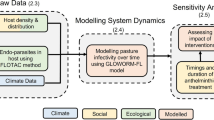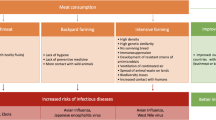Abstract
In common with much of theEnglish-speaking world, New Zealandersgenerally oppose the use of animalexperimentation where there is no demonstrableand immediate benefit for human, animal, orenvironmental health. Intrusive experiments onsheep internal and external parasites publishedbetween 1996 and 2000 are reviewed, anddiscussed in relation to these publicsensibilities. A total of 16 publishedexperiments on sheep parasites involvedsurgical manipulations or other intrusiveprocedures. Some of these experiments had noshort-term application, or the only applicationwas in increasing animal production. Otherscould have been modified at some extra expenseso that they were less intrusive. Still otherswere duplications of previous work. All thesemanipulations would be unacceptable accordingto the orthodox morality of the general public.Breeding programs, rotation of grazing,``low-tech'' vaccination, and in vitromodels of sheep can provide insights intopreventing parasite infestation withoutintrusive experiments. Such research protocolsshould take priority over existing programs.The results also confirm earlier reports thatanimal ethics committees are not fulfillingtheir mandated objective of acting as watchdogsfor the public. Possible changes in New Zealandanimal welfare legislation and itsinterpretation by Animal Ethics Committees arediscussed.
Similar content being viewed by others
REFERENCES
Aldhouse, P. A., A. Coghlan, and J. Copley, “Let the People Speak,” New Scientist, 22May 1999, 26–31.
ANZCCART, ANZCCART Information Package for Animal Ethics Committees (1998).
Bayvel, A. C. D., “The New Zealand Regulatory Approach to the Use of Live Animals in Research, Testing and Teaching,” in M. Balls, A-M. van Zeller, and M. E. Halder (eds.), Progress in the Reduction, Refinement and Replacement of Animal Experimentation (Elsevier, London, 2000), pp. 1023–1031.
Bisset, S. A., C. A. Morris, D. R. Squire, and S. M. Hickey, “Genetics of Resilience to Nematode Parasites in Young Romney Sheep - Use of Weight Gain Under Challenge to Assess Individual Anthelmintic Treatment Requirements,” New Zealand Journal of Agricultural Research 39 (1996), 314–323.
Blackwell, G. L., M. A. Potter, Y. H. Cottam, and H. T. Blair, “Susceptibility of Romney and Perendale Sheep to Flystrike by the Australian Green Fly, Lucilia cuprina (Weid.), and Fly Attractant Trials,” Proceedings of the New Zealand Society for Animal Production 57 (1997), 37–40.
Cripps, A. W. and T. L. W. Rothwell, “Immune Responses of Sheep to the Parasitic Nematode Trichostrongylus colubriformis: Infestations in Thirty-Vella Loops,” Australian Journal of Experimental Biology and Medical Science 56 (1973), 99–106.
DeGrazia, D., Taking Animals Seriously. Mental Life and Moral Status (Cambridge University Press, 1996).
de Leeuw, W. A. and P. de Greeve, “Production of Polyclonal and Monoclonal Antibodies in The Netherlands,” in L. M. F. van Zutphen and M. Balls (eds.), Animal Alternatives, Welfare and Ethics (Elsevier Science, London, 1997), pp. 1053–1059.
Dohoo, S. E. and I. R. Dohoo, “Factors Influencing the Postoperative Use of Analgesics in Dogs and Cats by Canadian Veterinarians,” Canadian Veterinary Journal 37 (1996), 552–556.
Ewen-Street, I., “Opinion - Organic Farming,”Soil and Health 58(5) (1999), 27–28.
FAO (2000). <http://apps.fao.org>http://apps.fao.org
Fitzgerald, G., R. Wilkinson, and L. Saunders, “Public Perceptions and Issues in Possum Control,” in T. L. Montague (ed.), The Brushtail Possum: Biology, Impact and Management of an Introduced Marsupial (Manaaki Whenua Press, Lincoln, 2000), pp. 187–196.
Flecknell, P., “Avoidance and Alleviation of Pain and Distress,” in L. M. F. van Zutphen and M. Balls (eds.), Animal Alternatives, Welfare and Ethics (Elsevier Science, London, 1997), pp. 241–245.
Galfré, G. and C. Milstein, “Preparation of Monoclonal Antibodies: Strategies and Procedures,” Methods in Enzymology 73 (1981), 3–46.
Hansen, B. and E. Hardie, “Prescription and Use of Analgesics in Dogs and Cats in a Veterinary Teaching Hospital: 258 Cases (1983- 1989),” Journal of the American Veterinary Medical Association 202 (1993), 1485–1494.
Harrison, G. B. L., H. D. Pulford, T. K. Gatehouse, R. J. Shaw, A. Pfeffer, and C. B. Shoemaker, “Studies on the Role of Mucus and Mucosal Hypersensitivity Reactions During Rejection of Trichostrongylus colubriformis from the Intestine of Immune Sheep Using an Experimental Challenge Model,” International Journal for Parasitology 29 (1999), 459–468.
Lampkin, N., Organic Farming (Farming Press, Tonbridge, 1999).
Lawton, D. E. B., G. W. Reynolds, S. M. Hodgkinson, W. E. Pomroy, and H. V. Simpson, “Infection of Sheep with Adult and Larval Ostertagia circumcincta: Effects on Abomasal PH and Serum Gastrin and Pepsinogen,” International Journal for Parasitology 26 (1996), 1063–1074.
Leahy, M. P. T., Against Liberation: Putting Animals in Perspective (Routledge: London and New York, 1991).
Leathwick, D. M. and D. S. Atkinson, “Dagginess and Flystrike in Lambs Grazed on Lotus corniculatus or Ryegrass,” Proceedings of the New Zealand Society of Animal Production 55 (1995), 196–198.
Leathwick, D. M. and D. S. Atkinson, “Influence of Different Proportions of Lotus corniculatus in the Diet of Lambs on Dags, Flystrike and Animal Performance,” Proceedings of the New Zealand Society of Animal Production 56 (1996), 99–102.
Linzey, A., Animal Theology (SCM Press, London, 1994).
MAF, Code of Recommendations and Minimum Standards for the Care and Use of Animals for Scientific Purposes (1995).
MAF, Animal Use Statistics: Instructions for Use (2001).
Malakoff, D, “Researchers Fight Plan to Regulate Mice, Birds,” Science 290 (2000a), 23.
Malakoff, D., “Research Group Wins Delay in Rules,” Science 290 (2000b), 243–244.
McArdle, J., “A Review of Common Misconceptions Associated with the in vivo Ascites and in vitro Production of Monoclonal Antibodies,” in M. Balls, A-M. van Zeller, and M.E. Halder (eds.), Progress in the Reduction, Refinement and Replacement of Animal Experimentation (Elsevier, London, 2000), pp. 857–863.
McCaw, A.,”The Three Rs and How They Are Promoted,” in D. Mellor, M. Fisher, and G. Sutherland (eds.), Ethical Approaches to Animal-Based Science, Proceedings of the Joint ANZCCART/ANEAC Conference, Auckland, New Zealand 1997, pp. 85–90.
Merritt, G. C. and J. E. Watts, “An in vitro Technique for Studying Fleece-Rot and Fly Strike in Sheep,” Australian Veterinary Journal 54 (1978), 513–516.
Morris, C. A., A. Vlassoff, S. A. Bisset, R. L. Baker, C. J. West, and A. P. Hurford, “Responses of Romney Sheep to Selection for Resistance or Susceptibility to Nematode Infection,” Animal Science 64 (1997), 319–329.
Morris, M. C., “Animal Care Ethics, ANZCCART, and Public Perceptions of Animal Ethics,” Journal of Agricultural and Environmental Ethics 13 (2000a), 249–257.
Morris, M. C., “Ethical Issues Associated with Sheep Fly Strike Research, Prevention and Control,” Journal of Agricultural and Environmental Ethics 13 (2000b), 205–217.
Morris, M. C. and S. A. Weaver, “Minimizing Harm in Agricultural Animal Experiments in New Zealand,” Journal of Agricultural and Environmental Ethics (2003), in press.
National Academy of Sciences, Recognition and Alleviation of Pain and Distress in Laboratory Animals (National Academy Press, Washington, DC, 1992).
Niklas, W., “Alternatives to Freund's Adjuvant,” in van L. F. M. Zutphen and M. Balls (eds.), Animal Alternatives, Welfare and Ethics (Elsevier Science, London, 1997), pp. 1061–1064.
Niezen, J. H., W. A. G. Charleston, J. Hodgson, A. D. Mackay, and D. M. Leathwick, “Controlling Internal Parasites in Grazing Ruminants without Recourse to Anthelmintics: Approaches, Experiences and Prospects,” International Journal for Parasitology 26 (1996), 983–992.
Pernthaner, A., W. Cabaj, R. J. Shaw, B. Rabel, C. L. Shirer, M. Stankiewicz, and P. G. C. Douch, “The Immune Response of Sheep Surgically Modified with Intestinal Loops to Challenge with Trichostrongylus colubriformis,” International Journal for Parasitology 26 (1996), 415–422.
Pfeffer, A., P. G. C. Douch, R. J. Shaw, T. K. Gatehouse, B. Rabel, R. S. Green, C. L. Shirer, W. E. Jonas, and S. Bisset, “Sequential Cellular and Humoral Responses in the Abomasal Mucosa and Blood of Romney Sheep Dosed with Trichostrongylus axei,” International Journal for Parasitology 26 (1996), 765–773.
Pfeffer, A., M. D. Phegan, and J. Bany, “Detection of Homocytotropic Antibody in Lambs Infested with the Louse, Bovicola ovis, Using a Basophil Histamine-Release Assay,” Veterinary Immunology and Immunopathology 57 (1997), 315–325.
Radostis, O. M., D. C. Blood, and C. C. Gay, Veterinary Medicine: A Textbook of the Diseases of Cattle, Sheep, Pigs, Goats and Horses, 8th edn. (Balliere Tindall, London, 1994).
Rollin, B. E., Animal Rights and Human Morality (Prometheus, Buffalo, 1981).
SAFE, Submission for the Royal Commission on Genetic Modification, 16th February, 2001 (http://www.gmcommission.govt.nz).
Sandeman, R., (auB. Collins, and P. Carnegie, “A Scanning Electron Microscope Study of L. cuprina Larvae and the Development of Blowfly Strike in Sheep,” International Journal for Parasitology 16 (1987), 69–75.
Sapontzis, S. F., Morals, Reason, and Animals (Philadelphia, PA: Temple University Press, 1991).
Scobie, D. R., A. R. Bray, and D. O'Connell, “A Breeding Goal to Improve the Welfare of Sheep,” Animal Welfare 8 (1999), 391–406.
Scott, I., S. M. Hodgkinson, S. Khalaf, D. E. B. Lawton, M. G. Collett, G. W. Reynolds, W. E. Pomroy, and H.V. Simpson, “Infection of Sheep with Adult and Larval Ostertagia circumcincta: Abomasal Morphology,” International Journal for Parasitology 28 (1998a), 1383–1392.
Scott, I., S. M. Hodgkinson, D. E. B. Lawton, S. Khalaf, G. W. Reynolds, W. E. Pomroy, and H. V. Simpson, “Infection of Sheep with Adult and Larval Ostertagia circumcincta: Gastrin,” International Journal for Parasitology 28 (1998b), 1393–1401.
Scott, I., S. Khalaf, D. C. Simcock, C. G. Knight, G.W. Reynolds, W. E. Pomroy, and H. V. Simpson, “A Sequential Study of the Pathology Associated with the Infection of Sheep with Adult and Larval Ostertagia circumcincta,” Veterinary Parasitology 89 (2000), 79–94.
Shaw, R. J., D. J. Grimmett, M. J. Donaghy, T. K. Gatehouse, C. L. Shirer, and P. G. C. Douch, “Production and Characterisation of Monoclonal Antibodies Recognising Ovine IgE,” Veterinary Immunology and Immunopathology 51 (1996), 235–251.
Shaw, R. J., T. K. Gatehouse, and M. M. McNeill, “Serum IgE Responses During Primary and Challenge Infections of Sheep with Trichostrongylus colubriformis,” International Journal for Parasitology 28 (1998), 293–302.
Shoemaker, C., FRST grant application C10616 (1999).
Simpson, H. V., D. E. B. Lawton, D. C. Simcock, G. W. Reynolds, and W. E. Pomroy, “Effects of Adult and Larval Haemonchus contortus on Abomasal Secretion,” International Journal for Parasitology 27 (1997), 825–831.
Simpson, H. V., B. H. Simpson, D. C. Simcock, G. W. Reynolds, and W. E. Pomroy, “Abomasal Secretion in Sheep Receiving Adult Ostertagia circumcincta that are Prevented from Contact with the Mucosa,” New Zealand Veterinary Journal 47 (1999), 20–24.
Singer, P. Animal Liberation: New Revised Edition (Avon Books, New York, 1990).
Stankiewicz, M. and E. Hadas, “Field Studies of the Immunisation of Lambs with Drug-Abbreviated Infections of Trichostrongylus colubriformis and Ostertagia circumcincta,” New Zealand Veterinary Journal 44 (1996), 182–184.
Sutherland, I. A., A. E. Brown, R. S. Green, C. M. Miller, and D. M. Leathwick, “The Immune Response of Sheep to Larval Challenge with Ostertagia circumcincta and O. ostertagi,” Veterinary Parasitology 84 (1999), 125–135.
Tellam, R. L. and V. M. Bowles, “Control of Blowfly Strike in Sheep: Current Strategies and Future Prospects,” International Journal for Parasitology 27 (1997), 261–273.
Wall, R., N. P. French, and K. L. Morgan, “Population Suppression for Control of the Blowfly Lucilia sericata and Sheep Blowfly Strike,” Ecological Entomology 20 (1995), 91–97.
Waller, P. J., “International Approaches to the Concept of Integrated Control of Parasites in Livestock,” International Journal for Parasitology 29 (1999), 155–164.
Wilkinson, R., G. Fitzgerald, and D. Chittenden, “Public and Interest Group Perceptions of Possum Fertility Controls: A Summary of the Focus Groups,” in Caught in the Headlights: New Zealander's Reflections on Possums, Control Options and Genetic Engineering (Parliamentary Commissioner for the Environment, Wellington, 2000).
Wilson, J. A., A. C. G. Heath, L. Stringfellow, N. A. Haack, and A. G. Clark, “Relative Efficacy of Organophosphorus Insecticides Against Susceptible and Resistant Strains of the Strike Blowfly Lucilia cuprina (Calliphoridae) in New Zealand Sheep,” New Zealand Veterinary Journal 44 (1999), 185–187.
Wise, S. M. Rattling the Cage (Pereus Books, Cambridge, MA., 2000).
Author information
Authors and Affiliations
Rights and permissions
About this article
Cite this article
Morris, M.C. Issues Associated with Research on Sheep Parasite Control in New Zealand – a Descriptive Ethic. Journal of Agricultural and Environmental Ethics 16, 187–207 (2003). https://doi.org/10.1023/A:1022990014756
Issue Date:
DOI: https://doi.org/10.1023/A:1022990014756




